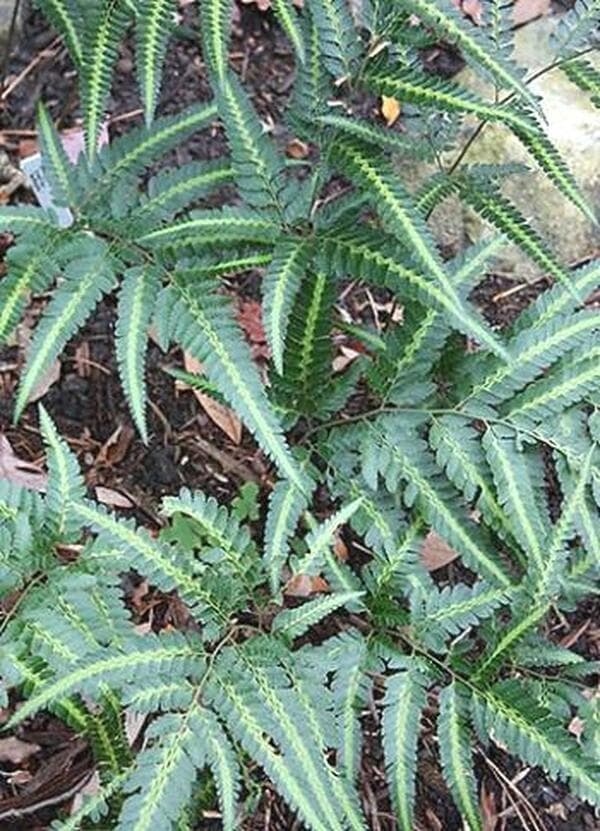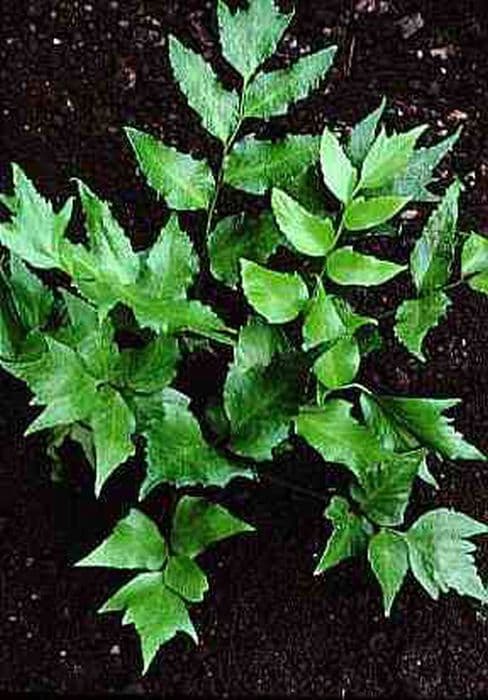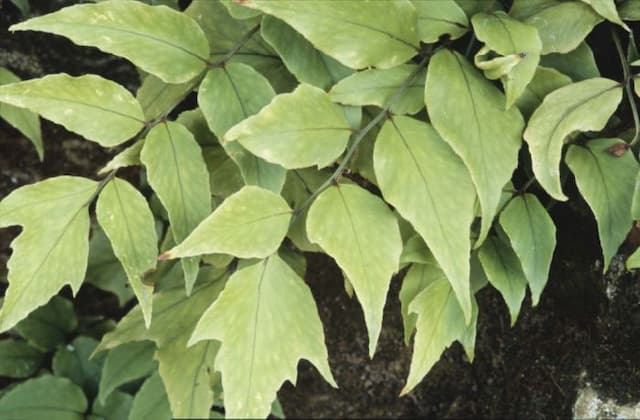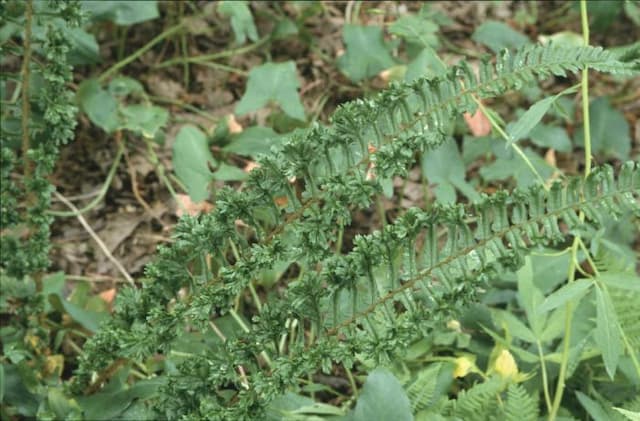Soft shield fern Polystichum setiferum Plumosomultilobum Group











ABOUT
The Polystichum setiferum Plumosomultilobum Group, commonly known as Soft Shield Fern, is recognized for its elegant and intricate foliage. This fern possesses a dense tuft of lance-shaped fronds that exhibit a lush, deep green color. Each frond is finely divided, resulting in a soft, feathery texture that is pleasing to both sight and touch. The fronds are composed of numerous small, leaf-like structures called pinnae, which are themselves highly subdivided, giving the Soft Shield Fern its characteristic fluffy appearance. These pinnae are arranged in a herringbone pattern along the frond, contributing to the plant's intricate visual texture. As with many ferns, the undersides of the fronds reveal a more muted color and may house the reproductive structures, which appear as small, rounded sori. The overall shape of the fronds can be described as arching, and they tend to create a visually soft, mounded form. The Soft Shield Fern's delicate and complex foliage makes it a striking addition to shaded gardens and woodland settings, where it adds a touch of elegance and fine texture.
About this plant
 Names
NamesFamily
Dryopteridaceae
Synonyms
Soft Shield Fern, Alaska Fern
Common names
Polystichum setiferum Plumosomultilobum Group.
 Toxicity
ToxicityTo humans
The plant commonly known as Soft Shield Fern (Polystichum setiferum) is not considered toxic to humans. There are no well-known toxic effects from ingesting or handling the Soft Shield Fern. As with any plant, individual allergies or sensitivities can occur, but this is not common for this species.
To pets
Similar to its effects on humans, Soft Shield Fern (Polystichum setiferum) is generally considered non-toxic to pets. It should not cause poisoning symptoms if ingested by animals such as cats and dogs. However, as with any non-food plant material, ingestion of large quantities may potentially cause mild stomach upset due to the fiber content or to a pet's individual sensitivity.
 Characteristics
CharacteristicsLife cycle
Perennials
Foliage type
Evergreen
Color of leaves
Green
Height
3 feet (0.91 meters)
Spread
2 feet (0.61 meters)
Plant type
Fern
Hardiness zones
8
Native area
Europe
Benefits
 General Benefits
General Benefits- Ornamental Appeal: The soft shield fern adds aesthetic value to gardens with its delicate, feathery fronds and lush green appearance.
- Shade Tolerance: As a fern, it thrives in shaded areas where other plants might struggle, making it ideal for woodland gardens or shady borders.
- Low Maintenance: It requires minimal care once established, making it a convenient choice for both novice and experienced gardeners.
- Wildlife Habitat: The dense foliage provides shelter and breeding grounds for various forms of wildlife, including insects and birds.
- Soil Erosion Control: The spreading nature of ferns helps to stabilize soil and prevent erosion in sloped or uneven areas of the garden.
- Drought Resistance: Once established, it can be relatively drought-tolerant, reducing the need for frequent watering.
- Year-Round Interest: In milder climates, the fern can retain its fronds throughout the year, offering greenery even in winter months.
 Medical Properties
Medical PropertiesThis plant is not used for medical purposes.
 Air-purifying Qualities
Air-purifying QualitiesThis plant is not specifically known for air purifying qualities.
 Other Uses
Other Uses- Soft shield ferns can be used in floral arrangements, especially for adding a touch of greenery with their delicately divided fronds, which can last for a significant period when cut and kept in water.
- These ferns can be planted to provide a textured backdrop in terrariums or miniature garden settings, contributing to a lush, green environment.
- Soft shield ferns serve as excellent ground cover plants in shady areas of the garden where other plants may struggle to thrive, thus preventing soil erosion.
- Creative gardeners might use dried soft shield fern fronds for crafting, such as in the making of bookmarks or adding a naturalistic element to handmade paper.
- The dense foliage of soft shield ferns can be utilized in theater or film production to create realistic forest scenes or to enhance set design with natural textures.
- Educational use in botany classes can be found, where the plant is used to teach students about fern reproductive cycles and spore-based propagation.
- During winter months, the persistent fronds of soft shield ferns offer visual interest in otherwise barren gardens, showcasing their resilience to frost.
- In urban environments, they can be integral to creating small green oases on balconies or in courtyard gardens, bringing a bit of woodland charm to city life.
- The plant can be incorporated into a sensory garden, where visitors are encouraged to touch and feel the contrast between the soft fern leaves and other plants.
- Soft shield ferns can act as a 'living mulch' by keeping the soil cool and moist during hot summers, thus reducing the need for additional mulching materials.
Interesting Facts
 Feng Shui
Feng ShuiThe Soft Shield Fern is not used in Feng Shui practice.
 Zodiac Sign Compitability
Zodiac Sign CompitabilityThe Soft Shield Fern is not used in astrology practice.
 Plant Symbolism
Plant Symbolism- Resilience - As an evergreen fern, Polystichum setiferum, commonly known as Soft Shield Fern, symbolizes resilience and the ability to endure through challenges, as it stays green throughout the seasons.
- Protection - Foliage that resembles a shield can be seen as a symbol of protection and safety, offering a metaphorical shield against adversity.
- Privacy - The dense and bushy growth habit of the Soft Shield Fern signifies a desire for privacy or solitude, as ferns often create secluded spaces in forests and gardens.
- Endurance - The Soft Shield Fern's sturdy nature and its ability to thrive in various conditions suggest endurance and the strength to last through hard times.
- Elegance - With its delicate, feathery fronds, the Soft Shield Fern can also represent elegance and gracefulness, adding a touch of beauty wherever it grows.
- Solitude - Often found growing alone or in quiet, undisturbed areas, it can symbolize a preference for solitude or introspection.
- Mystery - Ferns, in general, carry an air of mystery due to their prehistoric origins and the sheltered, shady environments they often inhabit.
 Water
WaterSoft shield ferns, like Polystichum setiferum Plumosomultilobum Group, should be watered deeply once a week, allowing the top inch of soil to dry out between waterings. During the active growing season in spring and summer, you may need to water more frequently, especially if the weather is particularly dry or hot. Aim to provide about one gallon of water per plant for each watering session to ensure the soil is evenly moistened. In the fall and winter, reduce watering to every other week since the plant's growth slows down and it requires less moisture
 Light
LightSoft shield ferns thrive in dappled shade or partial sunlight, making them well-suited for understory plantings or north-facing gardens. They should be shielded from direct afternoon sun to prevent leaf scorch, but they do need some indirect light to maintain their lush, green appearance. The ideal spot for these ferns would be under the canopy of deciduous trees or on the shady side of a building.
 Temperature
TemperatureSoft shield ferns prefer a cool to moderate temperature range, thriving best between 60°F and 75°F. It's important to protect them from extreme temperatures; they can handle a brief dip down to 50°F but should not be exposed to sustained cold or frost. Conversely, temperatures above 80°F can stress the plant, so provide extra shade and moisture during hotter periods.
 Pruning
PruningPrune soft shield ferns to remove any dead or damaged fronds, which will encourage healthy new growth and maintain an attractive appearance. The best time to prune is in early spring before new growth begins. These ferns may also be trimmed back in autumn if necessary, but it's often better to leave the fronds in place over winter to protect the crown of the plant.
 Cleaning
CleaningAs needed
 Soil
SoilThe Soft Shield Fern prefers a moist, well-draining soil mix rich in organic matter, with an acidic to neutral pH of 5.5 to 7. Add compost or leaf mold to enhance soil structure.
 Repotting
RepottingSoft Shield Ferns typically require repotting every 2-3 years to replenish soil nutrients and accommodate root growth.
 Humidity & Misting
Humidity & MistingSoft Shield Ferns thrive best in high humidity environments, ideally at or above 60% humidity, to mimic their natural forest habitat.
 Suitable locations
Suitable locationsIndoor
Place Soft Shield Fern in low to medium light, ensure humidity, and keep soil moist.
Outdoor
Plant in shady area with ample moisture and protect from drying winds.
Hardiness zone
7-9 USDA
 Life cycle
Life cycleSoft Shield Fern (Polystichum setiferum Plumosomultilobum Group) begins its life cycle as spores, which are produced under the fronds and released into the environment. When conditions are favorable, spores germinate to form a heart-shaped, tiny gametophyte, a sexual stage that develops reproductive organs. Sperm from male organs swim to the female organs to fertilize the egg, resulting in a diploid zygote. This zygote then grows into a young fern, or sporophyte, which is the main photosynthetic stage of the plant. As the fern matures, it develops a rhizome from which fronds emerge, unfurling as they grow and eventually reaching maturity to start the cycle again by producing new spores. Throughout its life, the Soft Shield Fern thrives in moist, shady environments and requires minimal maintenance once established, often living for many years and slowly increasing in size.
 Propogation
PropogationPropogation time
Spring-early summer
The Soft Shield Fern (Polystichum setiferum 'Plumosomultilobum Group') can be propagated through spore collection and sowing, but the most popular method is by division, typically done in spring. To divide this fern, you must carefully dig up the plant and split the clump into sections, ensuring each section has a piece of the root system and fronds. Use a sharp knife or spade to make the divisions, and then replant the sections into well-draining, moist soil at the same depth they were growing previously. Water the new divisions thoroughly to ensure they establish in their new environment. The divisions should be spaced about 12 to 24 inches apart (approximately 30 to 60 centimeters) to give them ample room to grow.









